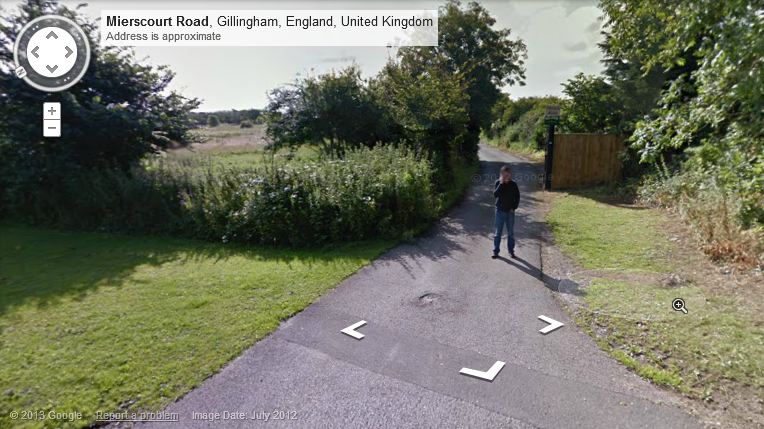In his History of Kent Hasted also says this of James Donet, who died in 1409, ‘On his death without male issue his sole daughter and heir, Margaret, carried this manor in marriage to John St. Leger esq., of Ulcombe, Sheriff anno 9, Henry VI, (1430-31) Hasted is mistaken in calling James Donet’s daughter Margaret; her name was Margery. Several generations of the Donet family lived at Siloam. John St. Leger who was knighted died in 1442. His memorial is the brass of a man in armour of the Lancastrian period which is mounted on a board in the north aisle of Ulcombe church (the inscription is missing) His wife Margery is buried beside him in Ulcombe church. A long line of St. Leger’s resided at Ulcombe, acquired manors and wealth, intermarried with the chief families of Kent and frequently served the office of Sheriff and represented the County in Parliament. They had four sons, Ralph the eldest, who succeeded his father at Ulcombe, Bartholomew, Thomas and James. Of the four Thomas was the one who left his mark on Rainham.
Some of you may remember that several years ago The Rev. R.Allington-Smith, a former vicar of Rainham, arranged an exhibition in the church entitled ‘The World of Thomas St.Leger’. This is what he said in the Publicity Release ‘Sir Thomas St.Leger, Knight of the Bath, lived from 1440 to 1483. Born of a Kentish family, the St.Legers of Ulcombe, he fought on the Yorkist side in the War of the Roses, became esquire and later knight of the body to King Edward IV and married the King’s sister, Anne of Exeter. He was much in favour with the King who employed him extensively in the affairs of the Kingdom, including foreign diplomacy. His connection with Rainham lies in the fact that he lived for a time at the manor of Siloam in this parish and was involved in the building of the great tower of the parish church. He was also instrumental in putting up the ‘canopy of honour’ inside the church painted with Yorkist ‘sun-in-splendour’ devices. The church is in fact a part of the exhibition.
After Edward IV’s death Thomas St.Leger, with many other Kentish knights, became implicated in Buckingham’s conspiracy against Richard III. After its collapse he was beheaded at Exeter in 1483’ It was once suggested that Sir Thomas lies buried in the chest-like monument under the easternmost arch of the arcade dividing the chancel from the chapel in St.Margaret’s church. As this is shorter than normal it was argued that it must contain the body of a headless individual namely Sir Thomas St.Leger. The truth is that he was interred alongside that of his wife in the Rutland Chantry in St. George’s Chapel, Windsor. He had founded it for Ann in 1481. Incorporated in the battlement on the north side of the tower of St. Margaret’s church are three shields, all eroded, one of which would probably have displayed the St. Leger coat of arms if Sir Thomas had been involved in the building of the tower.
The subject of who was responsible for the ‘canopy of honour’ or celure on the ceiling of the nave and its interpretation has given rise to much debate- but that is another story. Hasted continues ‘Sir Anthony St. Leger, (d.1559) lord deputy of Ireland in King Henry VIII th’s reign (1509-1547) sold the manor of Sileham, or Sileham-court to Christopher Bloor esq. who rebuilt his seat in this parish called Bloor's Place, in which his ancestors had resided for several generations.’
Christopher had a daughter, Olympiaz, who by her marriage to John Tufton of Hothfield, near Ashford in Kent, the Tuftons came to possess not only Siloam but other estates in the neighbouring parishes that were owned by the Bloor family. They remained in the possession of the Tufton family until sometime in the 20‘h C. John was Sheriff of Kent in 1575, knighted in 1603 and became a baronet in 1603. He was buried, along with Olympia and his second wife Christian Browne, in the vaults at Hothfield church. These were prone to flooding and so in 1770 their remains were brought to Rainham. Along with other members of the family they were placed in the vaults beneath the Tufton chapel in St. Margaret’s church which are thought to have been built by Olympia’s father. My paternal grandfather came from near Thame in Oxfordshire and moved to Kent at the end of the 19"‘ C looking for work. Wakeley’s who were farmers at Meresborough gave him employment and he lived at Siloam, which was owned by them. At that time it was divided into two parts to accommodate two families of farm workers. My father spent his childhood there and I visited Siloam, as a boy, a number of times to see my grandparents. In particular I can remember the enormous fireplace in the house and a pump in the yard where water was drawn from a well. The house and estate comprising 66 acres was sold off in parcels by auction in 1986. Notes: 1 A more reasonable explanation for the shortening of the tomb (if indeed it is a tomb) is that it was done in order to allow priests to pass from chancel to chapel. 2 Olympia died without having a son. Sir John’s descendants (who became Earls of Thanet) came from his second marriage, which produced six sons and four daughters.
Eric Cross






































































































